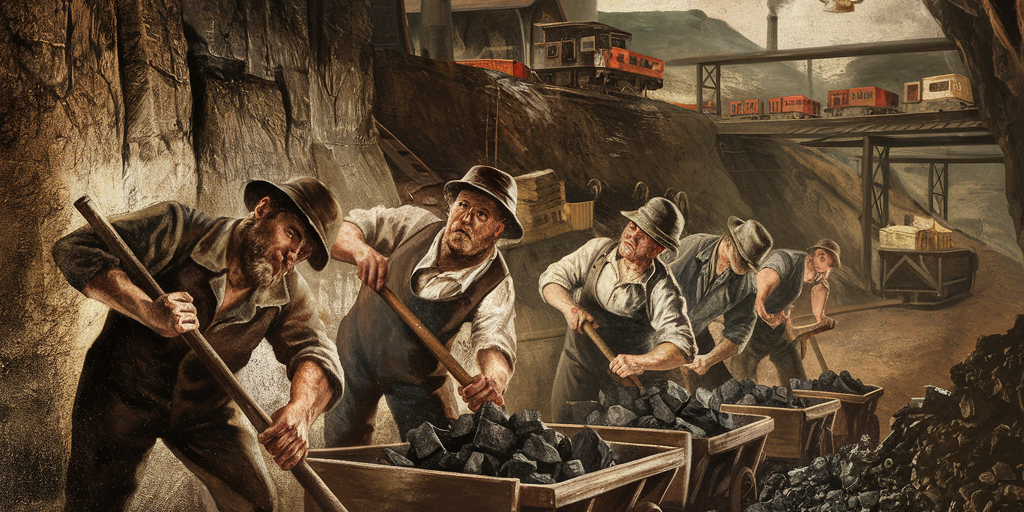Introduction: The Backbone of an Industrial Powerhouse
Before Pittsburgh became the Steel City, it was the Coal Capital of America. Throughout the 19th and early 20th centuries, Pittsburgh’s coal mining boom powered the steel mills, railroads, factories, and homes — not just locally, but across the growing United States.
Coal didn’t just shape Pittsburgh’s economy — it dug the rivers, carved the neighborhoods, and fueled the industrial revolution. This is the story of how Pittsburgh’s coal mines helped build a nation.
Coal Beneath the City: Why Pittsburgh Was Perfect for Mining
The Pittsburgh region sat atop one of the richest bituminous coal seams in the world — known as the Pittsburgh Coal Seam.
Key Factors:
- High-grade coking coal perfect for steel production.
- Close proximity to rivers and railroads for easy shipment.
- Demand from iron and glass works, steamships, and later, the steel mills.
By the 1830s, coal was already being extracted along Pittsburgh’s riverbanks, feeding the city’s booming industrial base.
The Rise of Coal Towns and Company Mines
As demand grew, mining expanded beyond the city and into the surrounding Monongahela River Valley, Allegheny County, and Greene County. Entire towns sprang up around coal mines, often controlled by powerful companies.
Famous Coal Towns and Regions:
- Castle Shannon (mines ran under Mount Washington)
- Homestead and Duquesne (later steel mill centers)
- Connellsville Coke Region
Life in the Coal Patch:
- Families lived in company-owned homes and bought from company stores.
- Child labor and dangerous conditions were common.
- Explosions, cave-ins, and black lung disease were daily risks.
Coal and the Rise of the Steel Empire
The real boom came when Pittsburgh’s steel industry exploded. Coal wasn’t just fuel — it became coke, the critical material needed to smelt iron ore into steel.
By the Numbers:
- By 1900, Pittsburgh was mining tens of millions of tons of coal annually.
- The region produced two-thirds of America’s coke.
- Coal trains and barges moved non-stop down the rivers to fuel mills like Carnegie Steel.
Pittsburgh’s coal industry didn’t just supply local mills — it powered railroads, steamships, and industries from Chicago to New York.
Labor Wars: Strikes, Unions, and Tragedies
The brutal conditions sparked labor unrest and violent strikes that shaped America’s labor movement:
Notable Events:
- The Coal and Iron Police: Hired by companies to suppress workers.
- The Westmoreland Coal Strike (1910-1911): One of the nation’s largest early coal strikes.
- Frequent mine disasters: Such as the Darr Mine explosion (1907), killing 239 men and boys.
Unions like the United Mine Workers of America (UMWA) emerged from Pittsburgh’s coal fields, forever changing labor history.
Environmental Impact: Pittsburgh’s Black Sky
Coal gave Pittsburgh wealth — but also left it infamous for pollution:
- Thick black smoke blanketed the city, earning it the nickname “Hell with the Lid Off.”
- Rivers ran black with coal dust and runoff.
- Entire landscapes were stripped bare, creating early examples of environmental devastation.
By the 1940s, Pittsburgh’s air quality was among the worst in the country, sparking early environmental reform efforts.
The Decline of King Coal
After World War II, demand for coal waned:
- Natural gas and oil replaced coal for heating.
- Steel industry decline reduced industrial demand.
- Stricter environmental regulations pushed out many mines.
By the 1970s, many of Pittsburgh’s once-mighty coal towns became ghost towns or suburbs, with only remnants of the mining era remaining.
Legacy: How Coal Shaped Pittsburgh’s Identity
While the mines closed, coal’s influence remains:
- Pittsburgh’s geography, neighborhoods, and population were shaped by mining.
- Many local families trace roots to coal miners and patch towns.
- Industrial giants — Carnegie, Frick, Mellon — built their empires on coal.
Today, Coal Heritage Sites, museums, and memorials across the region preserve the story of the men, women, and children who dug the city’s foundations.
Conclusion: The Fuel That Forged a Nation
Pittsburgh’s coal mining boom was more than local history — it was a national engine. The coal pulled from Western Pennsylvania’s hills built America’s steel, powered its trains, and lit its cities.
Though the mines have gone silent, their legacy remains etched in Pittsburgh’s identity, reminding us that before there was steel, there was coal — black gold that built a nation.









